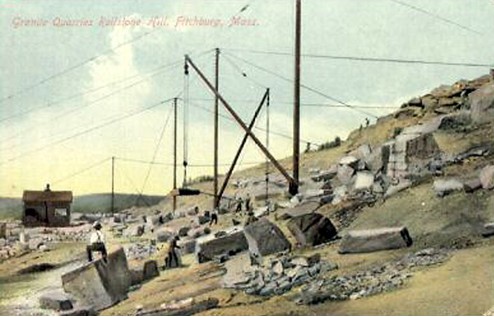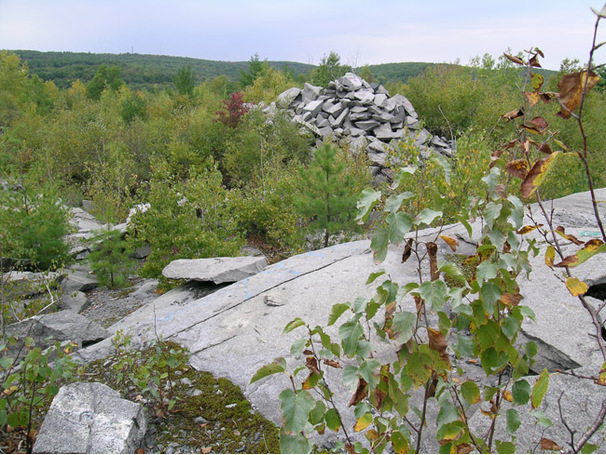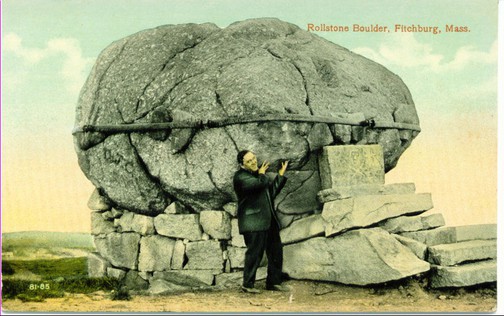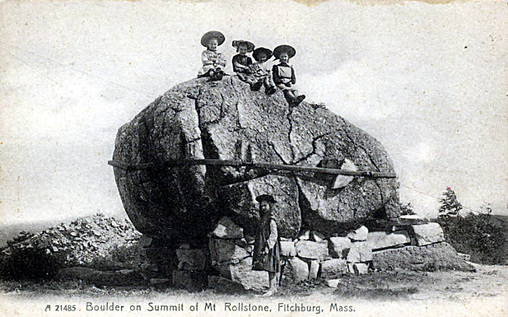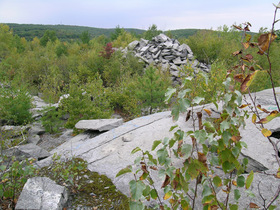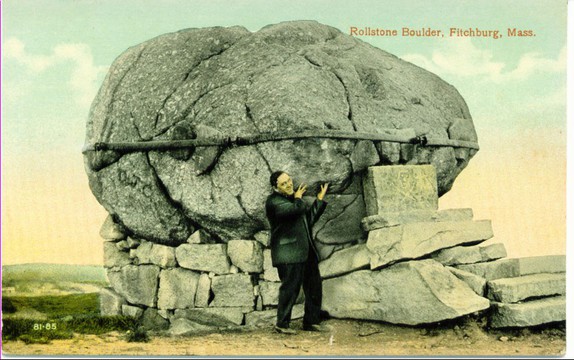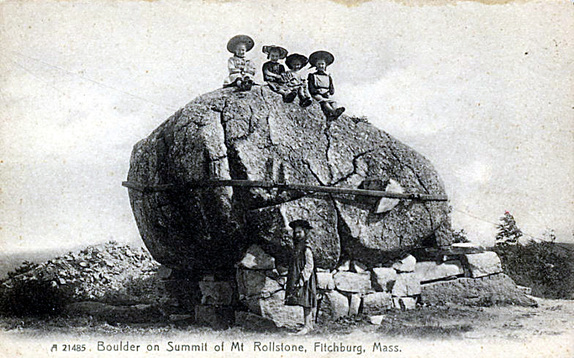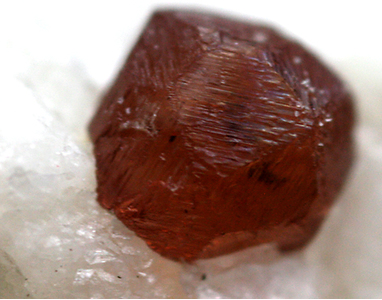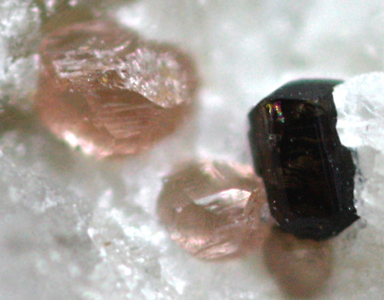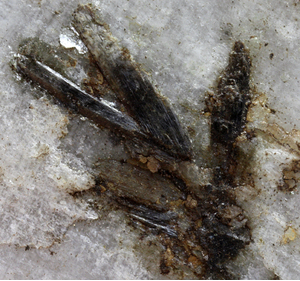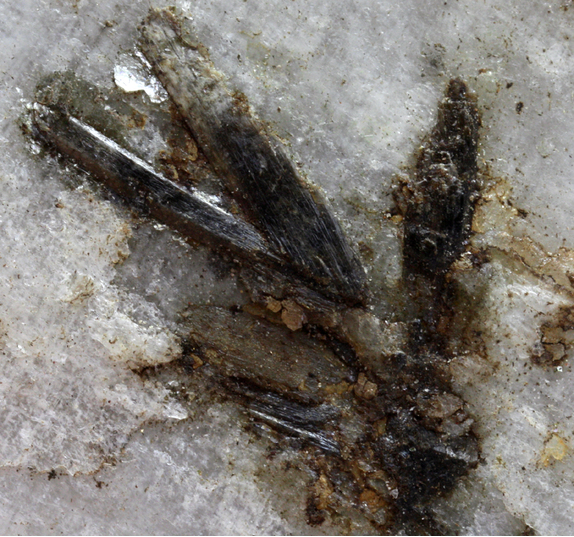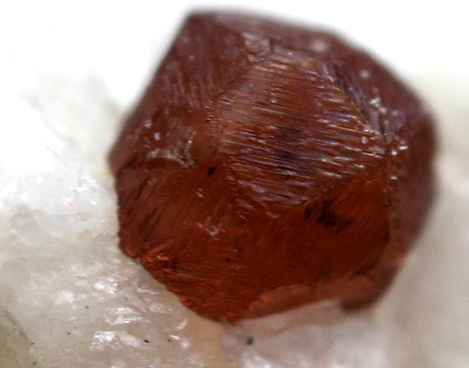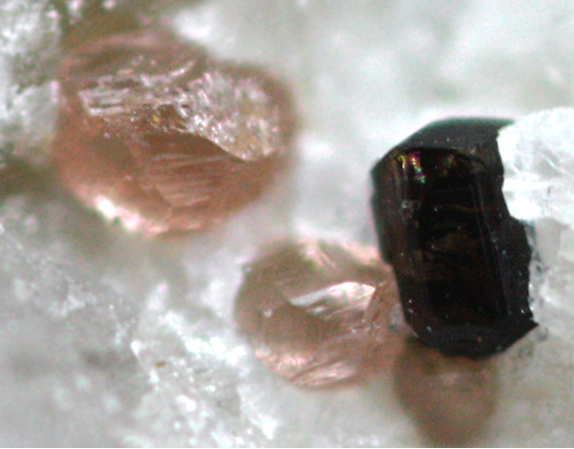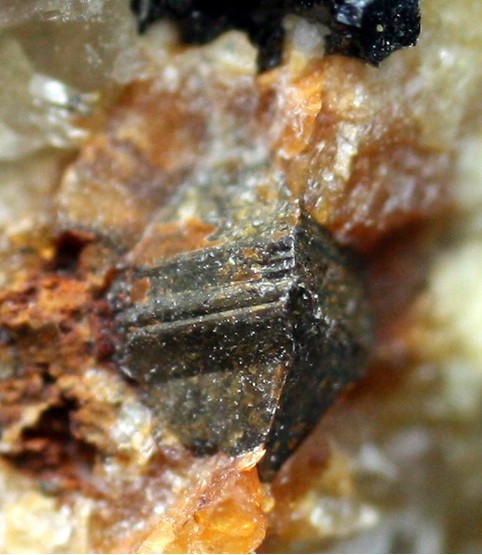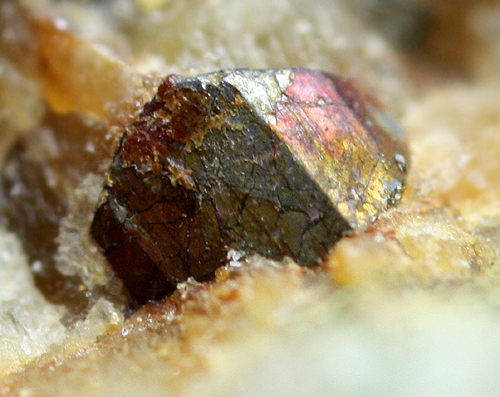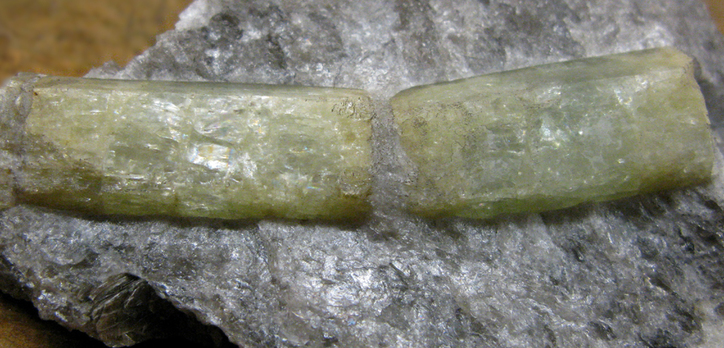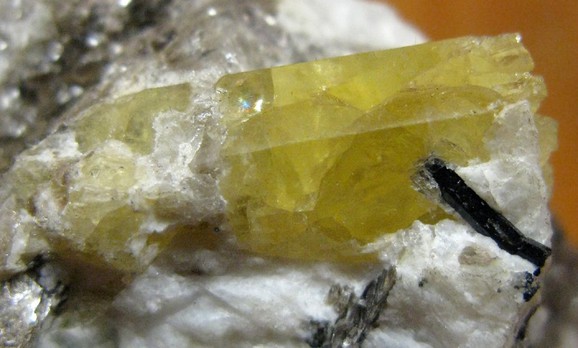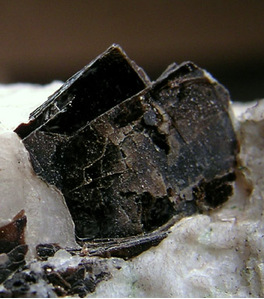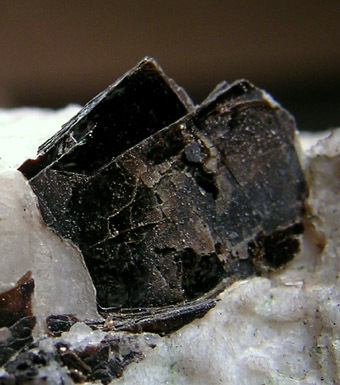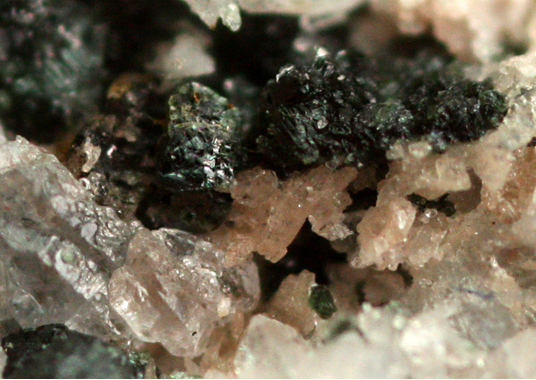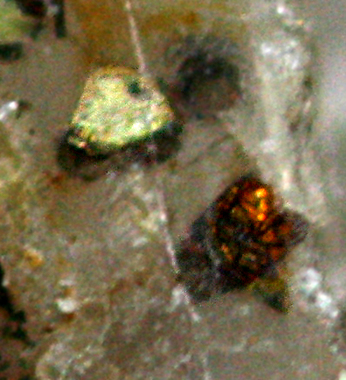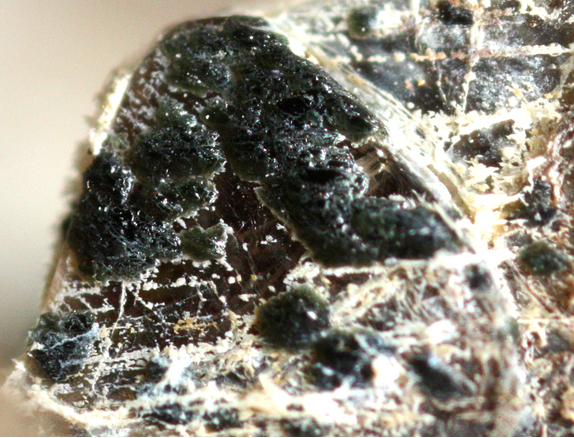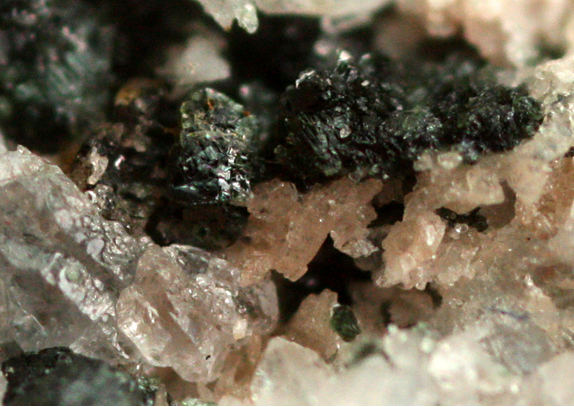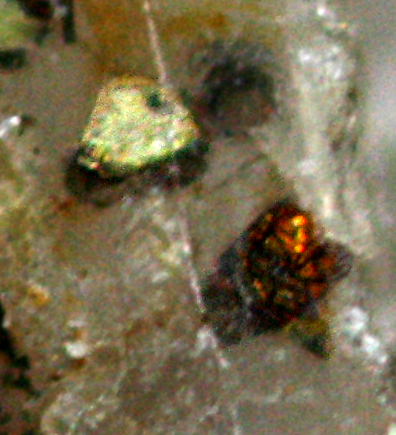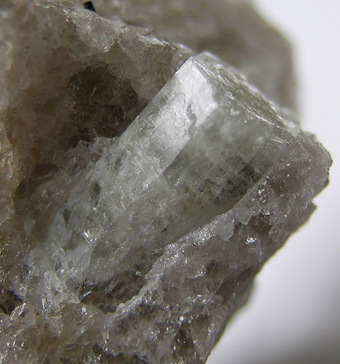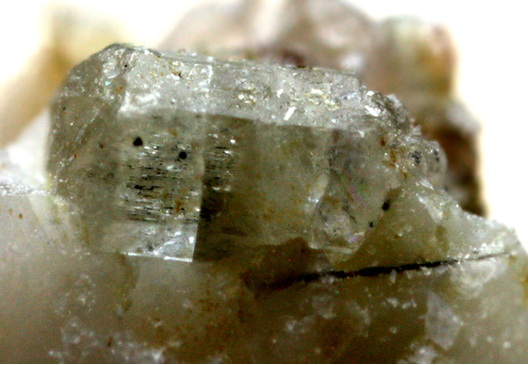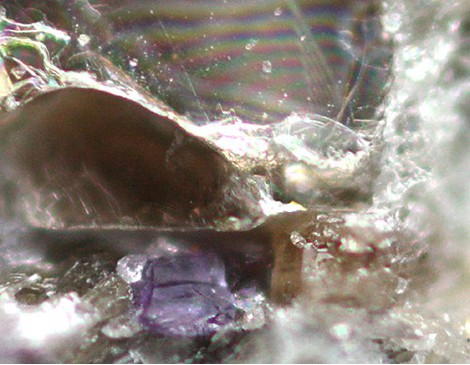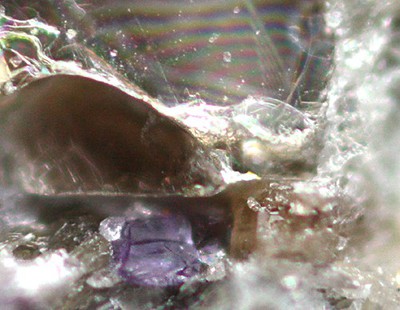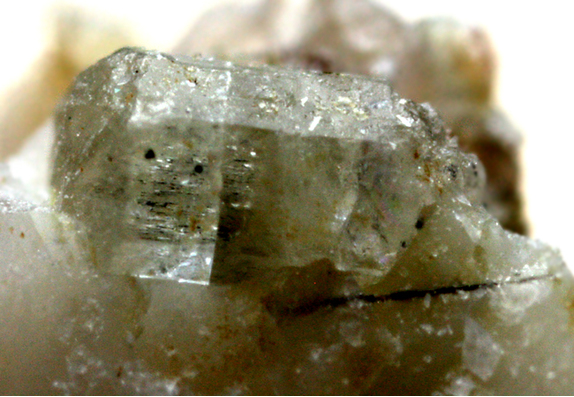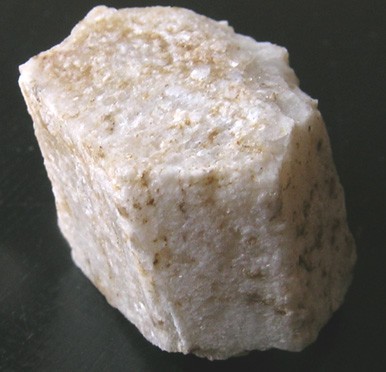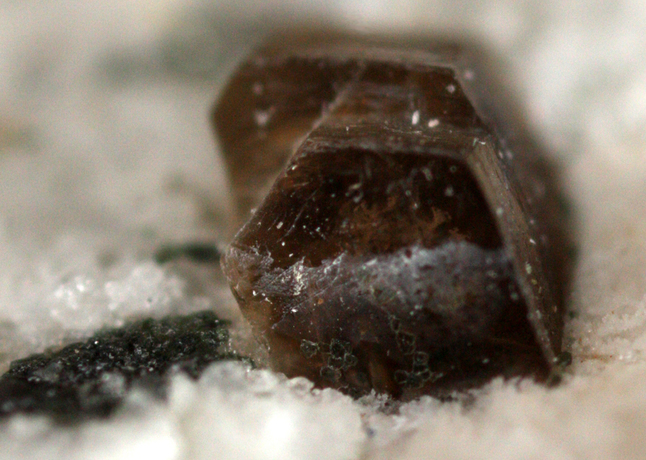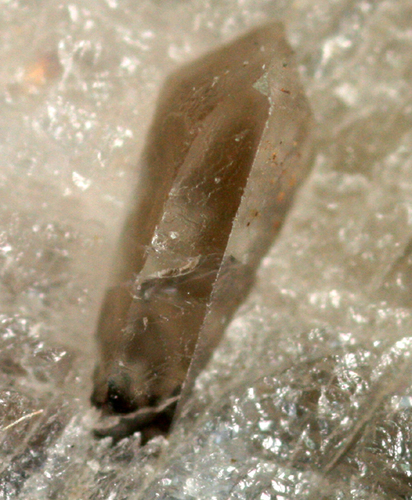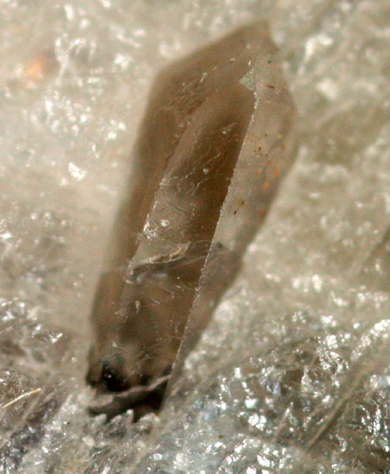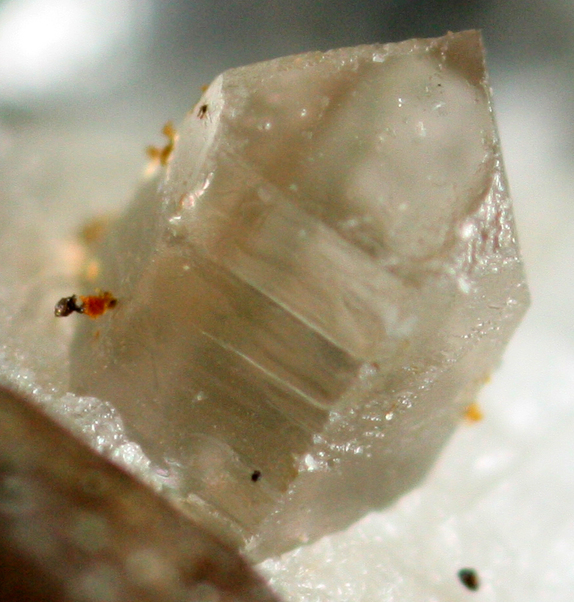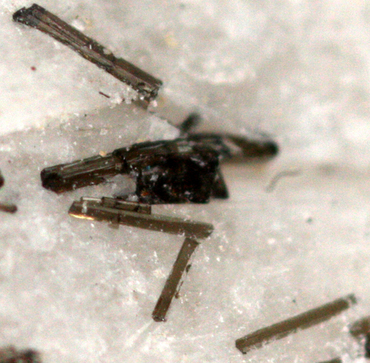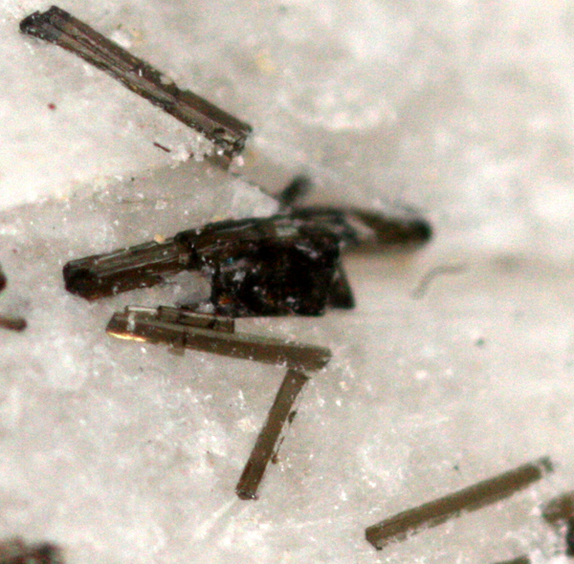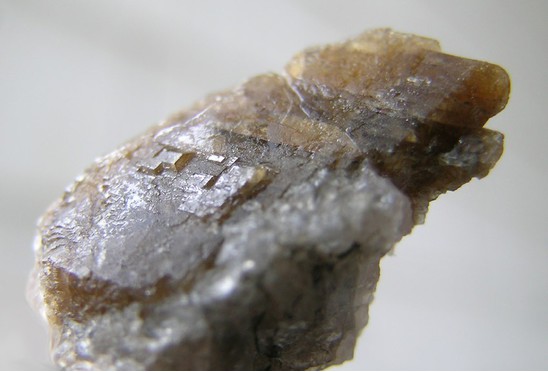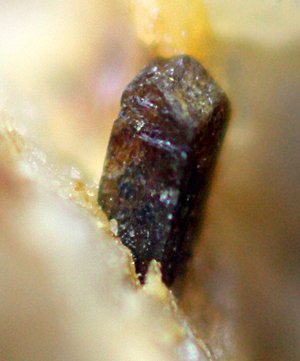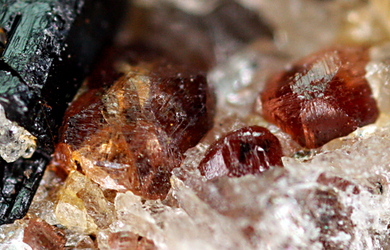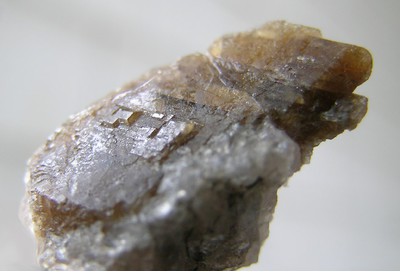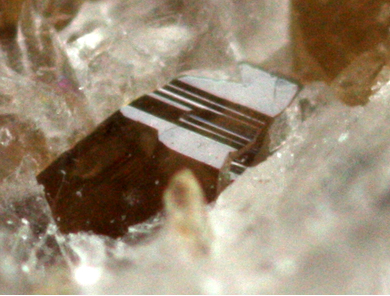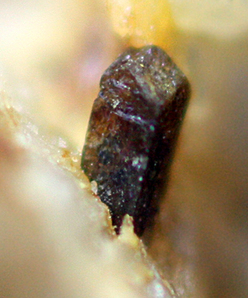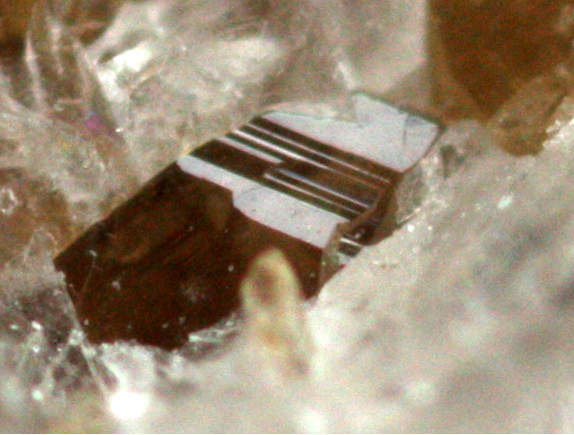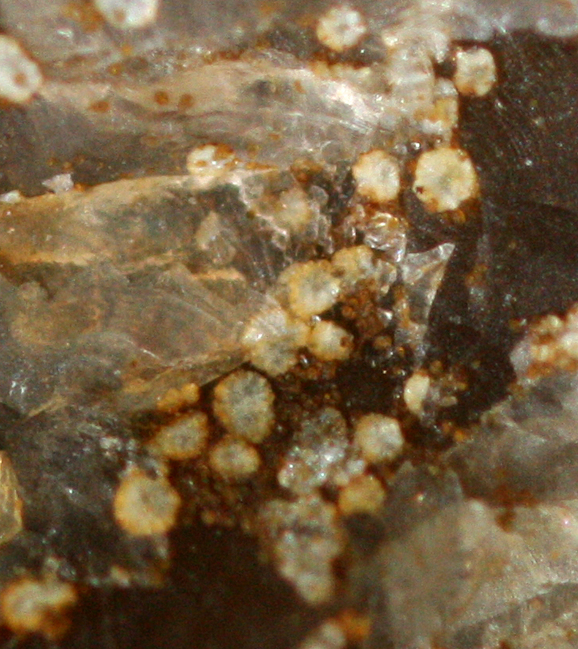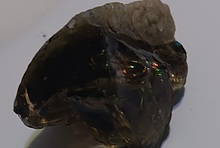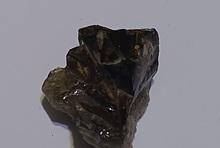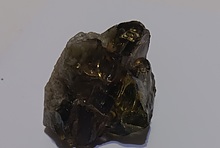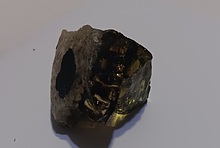Minerals of Rollstone Hill, Fitchburg, Massachusetts
Last Updated: 23rd Sep 2020By Peter Cristofono
Minerals of Rollstone Hill, Fitchburg, Massachusetts, USA
© 2012 Peter Cristofono
16 Howard St.
Salem MA 01970
Originally published in the Micromounters of New England Newsletter, no. 313, March, 2011.
Revised and Updated, February 2012.
Rollstone Hill is a prominent granite hill rising about 370 feet (113 m) above Fitchburg, Worcester County, in north central Massachusetts, to a total elevation of 835 feet (255 m) above sea level (42°34'44'' North, 71°48'32'' West). The city of Fitchburg currently owns 75 acres at and near the top of the hill, including woodland and former quarries. The name "Rollstone Hill" was in use as early as 1731, when the area was part of Lunenburg. (Fitchburg was incorporated as a town in 1764.)
Granite was first quarried on Rollstone Hill beginning sometime prior to 1830 (Carter & Brooks, 1830). The stone is a two-mica granite, named Fitchburg granite by Emerson (1917), now considered part of the Fitchburg Complex (Goldsmith et. al., 1982). Zartman and Naylor (1984) report the age of the Fitchburg Complex at Rollstone Hill as 390 ± 15 m.y. No contacts of the surrounding schist are present on the hill, but Hitchen (1935) observed isolated clots of biotite in the granite which he regarded as xenoliths of schist assimilated to varying extent. The granite was used both as dimension stone and as aggregate for construction purposes. At least six quarries were formerly worked on the hill including the (John) McCauliff, (O. E.) Litchfield, and (Henry) Godbeer quarries, with the McCauliff being the largest of these. In 1928, the McCauliff Quarry Company acquired the other quarries, which had been operated by independent companies. Quarry operations ceased in 1941. The quarries are composed entirely of granite.
C. Stanfield Hitchen (1935) studied pegmatites on Rollstone Hill and named the following types: (I) Biotite type; (II) Tourmaline type; (III) Beryl type; (IV) Titanite type; and (V) Allanite type. He described the Type II pegmatites (the most abundant) as up to 3 to 4 feet thick, Type III as up to 1 to 1.5 feet thick, and the other pegmatite types as no more than a few inches thick. He found that the pegmatites all occur within the granite, as veins, veinlets, pipelike bodies or irregular masses, and are without cavities. In addition, rare calcite veins also occur. Only one pegmatite, a beryl type, showed significant zonation, and gem beryl was collected from the quartz core.
A 100+ ton (90.7+ mt) glacial erratic, Rollstone Boulder, was once located on the summit of the hill, and was a minor tourist attraction, frequently depicted on early twentieth century postcards. Threatened by ongoing quarrying operations in the 1920s, the city of Fitchburg, by popular demand, paid to have the boulder blasted apart and reassembled on the upper common on Main Street, where it can still be seen today. Large white feldspar phenocrysts, clearly visible on the boulder, reveal that the stone is not Fitchburg granite, but porphyritic Kinsman quartz monzonite, a rock which occurs far to the north-northwest in New Hampshire (Mason, 1885; Palache, 1949; Gearan, 1969; Kirkpatrick, 1971; Skehan, 2001).
Twenty-eight mineral species have been reliably reported from Rollstone Hill. In addition to these, "biotite" is common, but the exact species is undetermined, though siderophyllite has been suggested by Hitchen (1935); "gummite" was reported as an alteration product of allanite (Emerson, 1917), but its exact nature is not known; spessartine is suspected, but unconfirmed; and columbite is reported, but doubtful. Three unidentified specimens may represent additional species. All specimens are in the author's collection except where noted. HMM = Harvard Mineralogical Museum.
Albite NaAlSi3O8
Albite microcrystals occur in calcite veins (Hitchen, 1935), and also as a late mineral associated with microcline in the pegmatites. The variety, oligoclase, (Na,Ca)[Al(Si,Al)Si2O8] occurs as a primary mineral (as anti-perthite) in phenocrysts in Type II pegmatites (Hitchen, 1935) and was also noted by Dale (1910, 1923), Emerson (1917) and Hurlbut (1964).
Allanite-(Ce) (Ca,Ce,Y)2(Al, Fe2+, Fe3+)3(SiO4)(Si2O7)(O)(OH). Epidote Group.
Allanite occurs as dark green or brown to black crystals, superficially weathering to orange or dark red-brown. Crystals can be several centimeters in length and mostly occur in the Type V pegmatites. Two SEM-EDS analyses (this study) show that cerium is the dominant rare earth element, followed by appreciable Nd. The mineral is radioactive due to thorium content. Crystals are frequently curved. “Gummite” was reported by Emerson (1917) as an alteration product of allanite; Hitchen (1935) reported seeing an orange-colored metamict substance fringing the crystals (in thin sections). Allanite was also reported by Lewis (1927), Lane (1933), Kitson (1938), Savage (1938), Billings (1941), Bjareby (1962), Hurlbut (1964), Seaman (1976), Grauch & Zarinski (1976), and listed in Gleba (1978) as the variety “orthite.”
Almandine (Fe,Mn)3Al2Si3O12 Garnet Group.
Manganese-rich almandine occurs in crystals in Type III and IV pegmatites. Garnet also occurs as an accessory in granite. Color can be shades of red, orange or pink. Pink crystals are associated with micro brown schorl in muscovite variety “sericite.” Orange-red to red crystals, showing a combination of the dodecahedron and the trapezohedron (according to Hitchen, 1935), can be up to 2cm in diameter. The smaller ones are frequently transparent and gemmy. Hitchen (1935) reported an analysis showing a large spessartine component to the pegmatite garnet, and SEM-EDS (this study) of an orange-red crystal also shows high Mn content though still subordinate to Fe. (See also the entry for spessartine.) “Garnet” was also reported by Dale (1910, 1923), Lewis (1927), Savage (1938), Billings (1941) and Hurlbut (1964); “red garnet” by Emerson (1917); “almandine” or “almandite” by Bjareby (1962) and Gleba (1978).
Arsenopyrite FeAsS
Sulfides are uncommon on Rollstone Hill; Hitchen (1935) reported that arsenopyrite is the most abundant, and that polished sections showed it to be free of intergrowths and inclusions. Also listed by Savage (1938) and Billings (1941).
Autunite Ca(UO2)2(PO4)2•11H2O
Autunite was reported by Grauch & Zarinski (1976). Not observed in the present study.
Beryl Be3Al2(Si6O18)
Gem beryl has been reported from Rollstone Hill, mostly the golden variety. The earliest report was by Hamlin (1870) who stated: “At the quarries at Fitchburg, beryl of a rich golden hue, approaching the chrysoberyl and topaz in color and hardness, and closely resembling the yellow diamond in lustre, have been blasted out.” Yellow or golden beryl was again reported by Hamlin (1873, 1884) and also by Burbank (1879), Schaller (1918), and McCaskey (1919). Aquamarine was reported by Emerson (1917), and beryl without a color specified was reported by Hiller (1974) and Sinkankas (1989). Hitchen (1935) noted that Rollstone beryl colors range from pale green to deep golden yellow. Most crystals are non-gem quality and occur in the Type III beryl pegmatite. Some crystals are offset and “healed” by quartz. The Type III pegmatite was observed in place (this study), and in nearby quarried boulders where very pale green beryl was observed frozen in matrix. In recent years, beryl has been rarely found, now that the quarry has been inactive for so long. Nevertheless, mineral collector Mike Shih of the Boston Mineral Club, discovered a new occurrence of colorless to pale green crystals in a small boulder in 2010.
"Biotite"
Biotite is a general name for a dark mineral of the Mica Group. Biotite occurs in Type I pegmatites in plates up to an inch in diameter (Billings, 1941), where it is associated with microcline, albite, muscovite and minor magnetite. It also occurs with muscovite in granite. Hitchen (1935) reported refractive indices which suggested that this black mica may be the mineral siderophyllite. Biotite was also reported by Dale (1910, 1923), Emerson (1917), Kitson (1938), Savage (1938), Billings (1941) and Hurlbut (1964).
Calcite CaCO3
Massive calcite occurs rarely in veins, enclosing microcrystals of quartz, muscovite, albite, chamosite, titanite, ilmenite and fluorite. Calcite veins were described by Hitchen (1935). Calcite was also listed by Savage (1938).
Chalcopyrite CuFeS2
Hitchen (1935) noted chalcopyrite crystals associated with pyrrhotite.
Chamosite (Fe2+, Mg)5Al(AlSi3O10)(OH)8 Chlorite Group.
Chamosite is dark green and is found with ilmenite and titanite in calcite veins and as an alteration of biotite in Type II and Type IV pegmatites. “Chlorite” was reported by Dale (1910, 1923) and Hitchen (1935). “Prochlorite” was listed by Seaman (1976). SEM-EDS analysis (this study) of a dark green chlorite mineral from a calcite vein proved to be chamosite.
"Columbite" (?) (Fe2+,Mn)(Nb,Ta)2O6
Columbite was listed by Kitson (1938), Billings (1941), Grauch & Zarinski (1976) and Gleba (1978). No specimen or analysis known; may be misidentified ilmenite.
Epidote Ca2Al2(Fe3+;Al)(SiO4)(Si2O7)O(OH)
Epidote was reported by Dale (1910) as a secondary mineral in granite.
Fluorapatite Ca5(PO4)3F
Apatite was reported by Hitchen (1935) as a “very rare” mineral occurring in crystals up to 2.5 cm long in the Type III beryl pegmatite, and as an accessory in the Type IV veins. In the present study, it has also been found in the Type II pegmatites, where it is frequently light gray in color and can be difficult to distinguish in the field from quartz. The fluorapatite occurs in simple hexagonal crystals, light gray, colorless or very pale green or greenish yellow, and exhibits strong yellow fluorescence under SW ultraviolet light. Billings (1941) also listed apatite from pegmatite. Apatite was reported as an accessory in granite by Dale (1910, 1923) and Hitchen (1935).
Fluorite CaF2
Fluorite occurs as colorless or purple cubic microcrystals in calcite veins (Hitchen, 1935). Savage (1938) also listed purple fluorite.
"Gummite"(?)
Gummite was reported as an alteration product of allanite (Emerson, 1917). See entry for allanite-(Ce).
Ilmenite Fe2+TiO3
Black crystals of ilmenite occur in Type II and Type IV pegmatites and in calcite veins, sometimes superficially weathering to a bluish color. SEM-EDS analysis (this study) of one sample showed the presence of minor Mn and Mg. Ilmenite was noted by Warren (1918), Hitchen (1935), Kitson (1938), Savage (1938), Billings (1941), Bjareby (1962) and listed by Gleba (1978).
Magnetite Fe3O4
Magnetite was reported by Hitchen (1935) as microscopic grains associated with biotite in the Type I pegmatites.
Marcasite FeS2
Marcasite was seen by Hitchen (1935) in polished section, occurring as concretionary masses resulting from supergene alteration of pyrrhotite.
Microcline KAlSi3O8
Microcline occurs as a component of microperthite in granite and pegmatite. Crude crystals occur on the walls of Type II pegmatites, while more perfect crystals, mostly Carlsbad twins, up to 8 cm long occur embedded in massive quartz (Hitchen, 1935). Microcline was also reported by Dale (1910, 1923), Emerson (1917), Lewis (1927), Bjareby (1962) and Hurlbut (1964).
Molybdenite MoS2
Molybdenite was reported by Hitchen (1935) as a rare mineral in fissures in the Type III (beryl) pegmatite, associated with sericite and garnet.
Muscovite KAl2AlSi3O10(OH)2 Mica Group.
Muscovite occurs in all pegmatites except Type V. In the Type III pegmatite, plates may be up to 4cm across (Hitchen, 1935). Muscovite also occurs as a constituent of granite, and as perfect pseudo-hexagonal crystals in calcite veins; also found as the fine-grained variety “sericite” in seams, associated with micro garnet and schorl crystals. Muscovite was noted by Emerson (1917), Dale (1923), Savage (1938), Kitson (1938) and Hurlbut (1964). Very rarely a pink variety, so-called “rose muscovite,” occurs in feldspar in pegmatite. This color variety was first noted by Carl Francis (pers. comm., 2010) on a Harvard Mineralogical Museum specimen; subsequently it was found as a rounded 2mm fine-grained aggregate (this study). Heinrich and Levinson (1953) attributed the color of specimens of rose muscovite they studied from various localities to the absence of Fe2+ and the dominance of Mn over Fe3+. Though not a factor in the color, the examples they studied contained a small amount of lithium and occurred in replacement units in zoned pegmatites. The cause of the pink color in examples from Rollstone Hill remains to be determined.
Opal (v. hyalite) SiO2•nH2O
This mineral was noted (this study) as strongly fluorescent (green, SW) colorless coatings on feldspar.
Orthoclase KAlSi3O8
Orthoclase was reported (as distinct from microcline) by Emerson (1917), Dale (1923) and Hurlbut (1964) as a component of granite.
Pyrite FeS2
Surprisingly rare on Rollstone Hill, this mineral was only seen once in this study — as an approximately 0.25mm modified cubic crystal, associated with much smaller chalcopyrite crystals and radial “sixling” twins of arsenopyrite. Previously listed by Savage (1938) in a field trip report, in which he also reported arsenopyrite.
Pyrrhotite Fe1-x S (x=0 to 0.17)
Pyrrhotite was reported by Hitchen (1935) as the second most common sulfide, after arsenopyrite.
Quartz SiO2
Quartz is almost always massive except for the nearly colorless crystals which occur in calcite veins. The massive quartz of the pegmatites is generally a light smoky color. (Dale, 1910, 1923; McCaskey, 1919; Hitchen, 1935; Savage, 1938; Bjareby, 1962)
Rutile TiO2
Rutile was reported in granite as micro-needles in quartz, albite and microcline (Dale, 1910, 1923; Emerson, 1917).
Schorl Na(Fe+32)Al6(Si6O18)(BO3)3(OH)3(OH) Tourmaline Group.
Schorl occurs abundantly in Type II pegmatites, sometimes in fine black crystals up to several inches in length. It also occurs in the Type III (beryl) pegmatite, and as an accessory in granite. Schorl, or black tourmaline, is the most collectible mineral at Rollstone Hill and is included in all prior lists of minerals from the locality (for example: Dale, 1910; Emerson, 1917; Hitchen, 1935; Kitson, 1938; Savage, 1938; Bjareby, 1962; Gaines, 1997). Hitchen (1935) described crystals that had been horizontally fractured and rehealed by quartz and feldspar, and crystals with quartz cores occurring along a vertical axis. He also noted schorl occurring as sooty aggregates of minute crystals; in graphic intergrowth with quartz (in the manner of some pegmatites in New Hampshire and Maine); and as groups of radiating crystals. A large and outstanding specimen of these radiating or "sunburst" schorl crystals is in the collection of the Harvard Mineralogical Museum. Schorl is also found as clusters of secondary translucent green-brown microcrystals on feldspar.
Siderophyllite (?) KFe2+2Al(Al2Si2)O10(F,OH)2 Mica Group. See entry for biotite.
Spessartine (?) (Mn,Fe)3Al2Si3O12 Garnet Group.
Spessartine has not been verified, but is suspected to occur as rare yellow to orange crystals and zones within crystals (this study). Hitchen (1935) reported an analysis of carefully selected garnet samples which were found to consist of an approximately 42% spessartine component and 53% almandine component, and were therefore technically almandine.
Titanite CaTiSiO5
Titanite occurs in brown crystals up to 2 cm across in Type IV pegmatite veins (Hitchen, 1935); also noted as pinkish-tan crystalline aggregates associated with chamosite in calcite veins. Titanite (“sphene”) was listed by Billings (1941), and mentioned as occurring in “good crystals” by Seaman (1976). Hitchen suggests that titanite occurs as a replacement of ilmenite, with which it is frequently associated.
Uraninite UO2
This mineral was reported by Lane (1933) who observed a 4mm sample, but was not seen by Hitchen (1935) or in the present study. Lane (1933) reported a uranium content of 50.2% in the analyzed portion of the sample.
Zircon ZrSiO4
Hitchen (1935) reported zircon from Type II and Type IV pegmatites, and as an accessory in granite. Sub-millimeter brown crystals were observed in the present study, associated with fluorapatite, almandine and ilmenite.
A bright yellow mineral was found associated with pyrrhotite and chalcopyrite, as an apparent alteration product (this study). Possibly native sulfur or a yellow iron sulfate mineral.
Unk-2
Off-white, radial crystal aggregates with a crude hexagonal outline, much smaller than 1mm, were found in association with allanite-(Ce) (this study). This mineral could be an alteration product of allanite-(Ce) such as the REE fluoro-carbonate, bastnäsite-(Ce).
Unk-3
White spheres were found in a fluorapatite-rich pegmatite vein associated with fluorapatite and schorl (this study); possibly a clay mineral or a secondary form of apatite.
Though the quarries have been inactive for more than 70 years, Rollstone Hill remains a promising source of fine schorl crystals. Continued investigation into its microminerals has the potential to extend the species list of the locality, and to be an important contribution to the mineralogy of Massachusetts and the New England region.
Thanks to Carl Francis, curator of the Harvard Mineralogical Museum, Cambridge, Massachusetts, for permission to photograph specimens from Rollstone Hill in the Harvard collection. Thanks also to Michael Shih for providing the beryl variety "goshenite" crystal. Grateful acknowledgment is also made to Kerry Day (Ottawa, Ontario) and Dr. Anthony Mariano (Carlisle, Massachusetts) who provided the SEM-EDS analyses.
- Billings, Marland P. (1941). Pegmatites of Massachusetts. Prepared under a cooperative project for geologic investigations in the Commonwealth of Massachusetts.
- Burbank, L. S. (1879). Proceedings of the Boston Society of Natural History, American Naturalist, Vol. 13, 1879.
- Bjareby, Gunnar (1962). Fifty Years of Mineral Collecting, Part V., Rocks & Minerals 37:565-568.
- Carter, James G. and William H. Brooks (1830). A Geography of Massachusetts (Boston: Hillard, Gray, Little and Wilkens), p. 146.
- Dale, T. Nelson (1910). Supplemental Notes on the Commercial Granites of Massachusetts (USGS Bulletin 470).
- Dale, T. Nelson (1923). The Commercial Granites of New England (USGS Bulletin 738).
- Emerson, Benjamin K. (1917). Geology of Massachusetts and Rhode Island (USGS Bulletin 597).
- Gaines, R. V., et. al. (1997). Dana’s New Mineralogy, 8th Edition, p. 1264.
- Gearan, John W. (1969). Legends Enshroud Rollstone and Its Boulder, Worcester Telegram & Gazette, Sept. 7, 1969.
- Gleba, Peter (1978). Massachusetts Mineral and Fossil Localities.
- Goldsmith, Richard; Grew, E.S.; Hepburn, J.C.; and Robinson, G.R. (1982). Formation names in the Worcester area, Massachusetts, in Stratigraphic Notes, 1980-1982 (USGS Bulletin 1529-H), pp. H43-H56.
- Grauch, R. I., and Zarinski, Katrin (1976). Generalized descriptions of uranium-bearing veins, pegmatites, and disseminations in non-sedimentary rocks, eastern United States (USGS Open-File Report 76-582).
- Hamlin, A. C. (1870). "The Gems of the United States" in Proceedings of the American Association for the Advancement of Science, Eighteenth Meeting, p. 212.
- Hamlin, A. C. (1873). The Emerald, Lippincott's Magazine of Popular Literature and Science, Vol.11 pp. 143-144.
- Hamlin, A. C. (1884). Leisure Hours Among Gems (Boston: James R. Osgood & Company), p. 313.
- Heinrich, E. W., and Levinson, A. A. (1953). Studies in the mica group; Mineralogy of the rose muscovites, American Mineralogist 38:25-49.
- Hiller, John (1974). Massachusetts Mines and Minerals (priv. pub.)
- Hitchen, C. Stanfield (1935). The Pegmatites of Fitchburg, Massachusetts, American Mineralogist 20:1-24.
- Hurlbut, C. S. Jr. (1964). "Some Mineral Localities West of Boston" in New England Intercollegiate Geol. Conf. Guidebook, 56th Annual Meeting, Oct. 2-4, 1964.
- Kirkpatrick, Doris (1971). The City and the River, Vol. 1. (Fitchburg, MA: Fitchburg Historical Society).
- Kitson, John (1938). R. & M. A. Outing in Massachusetts, Western Branch, Rocks & Minerals 13:245.
- Lane, Alfred C. (1933). Age of Fitchburg Granite, Science 78:435.
- Lewis, Lyman W. (1927). The Paragenesis of the Granite Pegmatite of Fitchburg, Massachusetts (abstract) in Proceedings of the Eighth Annual Meeting of the Mineralogical Society of America, American Mineralogist 13:113.
- Mason, Atherton P. (1885): Fitchburg in 1885. The Bay State Monthly, Vol. II, p. 341.
- McCaskey, H. D. (1919). Mineral Resources of the United States 1916, p. 891 (USGS).
- Palache, Charles (1949). The Fitchburg Rollstone, Rocks & Minerals 24:347.
- Savage, Henry G. (1938) [Field trip report; list of minerals] Boston Mineral Club newsletter, June 1938.
- Schaller, W.T. (1918). "Gems and Precious Stones" in Mineral Resources of the United States 1916, Part II, Nonmetals, p. 891.
- Seaman, David M. (1976). “Pegmatite Minerals of the World” in Januzzi, Ronald E. and Seaman, David M.: Mineral Localities of Connecticut and Southeastern New York State and Pegmatite Minerals of the World (Taylor Associates Inc./Mineralogical Press).
- Sinkankas, John (1989). Emerald and Other Beryls (Phoenix, Ariz.: Geoscience Press) p. 557.
- Skehan, James W. (2001). Roadside Geology of Massachusetts (Missoula, MT: Mountain Pub. Co.)
- Warren, Charles H. (1918). On the microstructure of certain titanic iron ores, Economic Geology 13(6):438.
- Zartman, Robert E. and Naylor, Richard S. (1984). Structural implications of some radiometric ages of igneous rocks in southeastern New England (abstract), GSA Bulletin 95(5):522-539.
© 2012 Peter Cristofono
16 Howard St.
Salem MA 01970
Originally published in the Micromounters of New England Newsletter, no. 313, March, 2011.
Revised and Updated, February 2012.
Introduction
Rollstone Hill is a prominent granite hill rising about 370 feet (113 m) above Fitchburg, Worcester County, in north central Massachusetts, to a total elevation of 835 feet (255 m) above sea level (42°34'44'' North, 71°48'32'' West). The city of Fitchburg currently owns 75 acres at and near the top of the hill, including woodland and former quarries. The name "Rollstone Hill" was in use as early as 1731, when the area was part of Lunenburg. (Fitchburg was incorporated as a town in 1764.)
Granite was first quarried on Rollstone Hill beginning sometime prior to 1830 (Carter & Brooks, 1830). The stone is a two-mica granite, named Fitchburg granite by Emerson (1917), now considered part of the Fitchburg Complex (Goldsmith et. al., 1982). Zartman and Naylor (1984) report the age of the Fitchburg Complex at Rollstone Hill as 390 ± 15 m.y. No contacts of the surrounding schist are present on the hill, but Hitchen (1935) observed isolated clots of biotite in the granite which he regarded as xenoliths of schist assimilated to varying extent. The granite was used both as dimension stone and as aggregate for construction purposes. At least six quarries were formerly worked on the hill including the (John) McCauliff, (O. E.) Litchfield, and (Henry) Godbeer quarries, with the McCauliff being the largest of these. In 1928, the McCauliff Quarry Company acquired the other quarries, which had been operated by independent companies. Quarry operations ceased in 1941. The quarries are composed entirely of granite.
C. Stanfield Hitchen (1935) studied pegmatites on Rollstone Hill and named the following types: (I) Biotite type; (II) Tourmaline type; (III) Beryl type; (IV) Titanite type; and (V) Allanite type. He described the Type II pegmatites (the most abundant) as up to 3 to 4 feet thick, Type III as up to 1 to 1.5 feet thick, and the other pegmatite types as no more than a few inches thick. He found that the pegmatites all occur within the granite, as veins, veinlets, pipelike bodies or irregular masses, and are without cavities. In addition, rare calcite veins also occur. Only one pegmatite, a beryl type, showed significant zonation, and gem beryl was collected from the quartz core.
A 100+ ton (90.7+ mt) glacial erratic, Rollstone Boulder, was once located on the summit of the hill, and was a minor tourist attraction, frequently depicted on early twentieth century postcards. Threatened by ongoing quarrying operations in the 1920s, the city of Fitchburg, by popular demand, paid to have the boulder blasted apart and reassembled on the upper common on Main Street, where it can still be seen today. Large white feldspar phenocrysts, clearly visible on the boulder, reveal that the stone is not Fitchburg granite, but porphyritic Kinsman quartz monzonite, a rock which occurs far to the north-northwest in New Hampshire (Mason, 1885; Palache, 1949; Gearan, 1969; Kirkpatrick, 1971; Skehan, 2001).
Minerals
Twenty-eight mineral species have been reliably reported from Rollstone Hill. In addition to these, "biotite" is common, but the exact species is undetermined, though siderophyllite has been suggested by Hitchen (1935); "gummite" was reported as an alteration product of allanite (Emerson, 1917), but its exact nature is not known; spessartine is suspected, but unconfirmed; and columbite is reported, but doubtful. Three unidentified specimens may represent additional species. All specimens are in the author's collection except where noted. HMM = Harvard Mineralogical Museum.
Albite NaAlSi3O8
Albite microcrystals occur in calcite veins (Hitchen, 1935), and also as a late mineral associated with microcline in the pegmatites. The variety, oligoclase, (Na,Ca)[Al(Si,Al)Si2O8] occurs as a primary mineral (as anti-perthite) in phenocrysts in Type II pegmatites (Hitchen, 1935) and was also noted by Dale (1910, 1923), Emerson (1917) and Hurlbut (1964).
Allanite-(Ce) (Ca,Ce,Y)2(Al, Fe2+, Fe3+)3(SiO4)(Si2O7)(O)(OH). Epidote Group.
Allanite occurs as dark green or brown to black crystals, superficially weathering to orange or dark red-brown. Crystals can be several centimeters in length and mostly occur in the Type V pegmatites. Two SEM-EDS analyses (this study) show that cerium is the dominant rare earth element, followed by appreciable Nd. The mineral is radioactive due to thorium content. Crystals are frequently curved. “Gummite” was reported by Emerson (1917) as an alteration product of allanite; Hitchen (1935) reported seeing an orange-colored metamict substance fringing the crystals (in thin sections). Allanite was also reported by Lewis (1927), Lane (1933), Kitson (1938), Savage (1938), Billings (1941), Bjareby (1962), Hurlbut (1964), Seaman (1976), Grauch & Zarinski (1976), and listed in Gleba (1978) as the variety “orthite.”
Almandine (Fe,Mn)3Al2Si3O12 Garnet Group.
Manganese-rich almandine occurs in crystals in Type III and IV pegmatites. Garnet also occurs as an accessory in granite. Color can be shades of red, orange or pink. Pink crystals are associated with micro brown schorl in muscovite variety “sericite.” Orange-red to red crystals, showing a combination of the dodecahedron and the trapezohedron (according to Hitchen, 1935), can be up to 2cm in diameter. The smaller ones are frequently transparent and gemmy. Hitchen (1935) reported an analysis showing a large spessartine component to the pegmatite garnet, and SEM-EDS (this study) of an orange-red crystal also shows high Mn content though still subordinate to Fe. (See also the entry for spessartine.) “Garnet” was also reported by Dale (1910, 1923), Lewis (1927), Savage (1938), Billings (1941) and Hurlbut (1964); “red garnet” by Emerson (1917); “almandine” or “almandite” by Bjareby (1962) and Gleba (1978).
Arsenopyrite FeAsS
Sulfides are uncommon on Rollstone Hill; Hitchen (1935) reported that arsenopyrite is the most abundant, and that polished sections showed it to be free of intergrowths and inclusions. Also listed by Savage (1938) and Billings (1941).
Autunite Ca(UO2)2(PO4)2•11H2O
Autunite was reported by Grauch & Zarinski (1976). Not observed in the present study.
Beryl Be3Al2(Si6O18)
Gem beryl has been reported from Rollstone Hill, mostly the golden variety. The earliest report was by Hamlin (1870) who stated: “At the quarries at Fitchburg, beryl of a rich golden hue, approaching the chrysoberyl and topaz in color and hardness, and closely resembling the yellow diamond in lustre, have been blasted out.” Yellow or golden beryl was again reported by Hamlin (1873, 1884) and also by Burbank (1879), Schaller (1918), and McCaskey (1919). Aquamarine was reported by Emerson (1917), and beryl without a color specified was reported by Hiller (1974) and Sinkankas (1989). Hitchen (1935) noted that Rollstone beryl colors range from pale green to deep golden yellow. Most crystals are non-gem quality and occur in the Type III beryl pegmatite. Some crystals are offset and “healed” by quartz. The Type III pegmatite was observed in place (this study), and in nearby quarried boulders where very pale green beryl was observed frozen in matrix. In recent years, beryl has been rarely found, now that the quarry has been inactive for so long. Nevertheless, mineral collector Mike Shih of the Boston Mineral Club, discovered a new occurrence of colorless to pale green crystals in a small boulder in 2010.
"Biotite"
Biotite is a general name for a dark mineral of the Mica Group. Biotite occurs in Type I pegmatites in plates up to an inch in diameter (Billings, 1941), where it is associated with microcline, albite, muscovite and minor magnetite. It also occurs with muscovite in granite. Hitchen (1935) reported refractive indices which suggested that this black mica may be the mineral siderophyllite. Biotite was also reported by Dale (1910, 1923), Emerson (1917), Kitson (1938), Savage (1938), Billings (1941) and Hurlbut (1964).
Calcite CaCO3
Massive calcite occurs rarely in veins, enclosing microcrystals of quartz, muscovite, albite, chamosite, titanite, ilmenite and fluorite. Calcite veins were described by Hitchen (1935). Calcite was also listed by Savage (1938).
Chalcopyrite CuFeS2
Hitchen (1935) noted chalcopyrite crystals associated with pyrrhotite.
Chamosite (Fe2+, Mg)5Al(AlSi3O10)(OH)8 Chlorite Group.
Chamosite is dark green and is found with ilmenite and titanite in calcite veins and as an alteration of biotite in Type II and Type IV pegmatites. “Chlorite” was reported by Dale (1910, 1923) and Hitchen (1935). “Prochlorite” was listed by Seaman (1976). SEM-EDS analysis (this study) of a dark green chlorite mineral from a calcite vein proved to be chamosite.
"Columbite" (?) (Fe2+,Mn)(Nb,Ta)2O6
Columbite was listed by Kitson (1938), Billings (1941), Grauch & Zarinski (1976) and Gleba (1978). No specimen or analysis known; may be misidentified ilmenite.
Epidote Ca2Al2(Fe3+;Al)(SiO4)(Si2O7)O(OH)
Epidote was reported by Dale (1910) as a secondary mineral in granite.
Fluorapatite Ca5(PO4)3F
Apatite was reported by Hitchen (1935) as a “very rare” mineral occurring in crystals up to 2.5 cm long in the Type III beryl pegmatite, and as an accessory in the Type IV veins. In the present study, it has also been found in the Type II pegmatites, where it is frequently light gray in color and can be difficult to distinguish in the field from quartz. The fluorapatite occurs in simple hexagonal crystals, light gray, colorless or very pale green or greenish yellow, and exhibits strong yellow fluorescence under SW ultraviolet light. Billings (1941) also listed apatite from pegmatite. Apatite was reported as an accessory in granite by Dale (1910, 1923) and Hitchen (1935).
Fluorite CaF2
Fluorite occurs as colorless or purple cubic microcrystals in calcite veins (Hitchen, 1935). Savage (1938) also listed purple fluorite.
"Gummite"(?)
Gummite was reported as an alteration product of allanite (Emerson, 1917). See entry for allanite-(Ce).
Ilmenite Fe2+TiO3
Black crystals of ilmenite occur in Type II and Type IV pegmatites and in calcite veins, sometimes superficially weathering to a bluish color. SEM-EDS analysis (this study) of one sample showed the presence of minor Mn and Mg. Ilmenite was noted by Warren (1918), Hitchen (1935), Kitson (1938), Savage (1938), Billings (1941), Bjareby (1962) and listed by Gleba (1978).
Magnetite Fe3O4
Magnetite was reported by Hitchen (1935) as microscopic grains associated with biotite in the Type I pegmatites.
Marcasite FeS2
Marcasite was seen by Hitchen (1935) in polished section, occurring as concretionary masses resulting from supergene alteration of pyrrhotite.
Microcline KAlSi3O8
Microcline occurs as a component of microperthite in granite and pegmatite. Crude crystals occur on the walls of Type II pegmatites, while more perfect crystals, mostly Carlsbad twins, up to 8 cm long occur embedded in massive quartz (Hitchen, 1935). Microcline was also reported by Dale (1910, 1923), Emerson (1917), Lewis (1927), Bjareby (1962) and Hurlbut (1964).
Molybdenite MoS2
Molybdenite was reported by Hitchen (1935) as a rare mineral in fissures in the Type III (beryl) pegmatite, associated with sericite and garnet.
Muscovite KAl2AlSi3O10(OH)2 Mica Group.
Muscovite occurs in all pegmatites except Type V. In the Type III pegmatite, plates may be up to 4cm across (Hitchen, 1935). Muscovite also occurs as a constituent of granite, and as perfect pseudo-hexagonal crystals in calcite veins; also found as the fine-grained variety “sericite” in seams, associated with micro garnet and schorl crystals. Muscovite was noted by Emerson (1917), Dale (1923), Savage (1938), Kitson (1938) and Hurlbut (1964). Very rarely a pink variety, so-called “rose muscovite,” occurs in feldspar in pegmatite. This color variety was first noted by Carl Francis (pers. comm., 2010) on a Harvard Mineralogical Museum specimen; subsequently it was found as a rounded 2mm fine-grained aggregate (this study). Heinrich and Levinson (1953) attributed the color of specimens of rose muscovite they studied from various localities to the absence of Fe2+ and the dominance of Mn over Fe3+. Though not a factor in the color, the examples they studied contained a small amount of lithium and occurred in replacement units in zoned pegmatites. The cause of the pink color in examples from Rollstone Hill remains to be determined.
Opal (v. hyalite) SiO2•nH2O
This mineral was noted (this study) as strongly fluorescent (green, SW) colorless coatings on feldspar.
Orthoclase KAlSi3O8
Orthoclase was reported (as distinct from microcline) by Emerson (1917), Dale (1923) and Hurlbut (1964) as a component of granite.
Pyrite FeS2
Surprisingly rare on Rollstone Hill, this mineral was only seen once in this study — as an approximately 0.25mm modified cubic crystal, associated with much smaller chalcopyrite crystals and radial “sixling” twins of arsenopyrite. Previously listed by Savage (1938) in a field trip report, in which he also reported arsenopyrite.
Pyrrhotite Fe1-x S (x=0 to 0.17)
Pyrrhotite was reported by Hitchen (1935) as the second most common sulfide, after arsenopyrite.
Quartz SiO2
Quartz is almost always massive except for the nearly colorless crystals which occur in calcite veins. The massive quartz of the pegmatites is generally a light smoky color. (Dale, 1910, 1923; McCaskey, 1919; Hitchen, 1935; Savage, 1938; Bjareby, 1962)
Rutile TiO2
Rutile was reported in granite as micro-needles in quartz, albite and microcline (Dale, 1910, 1923; Emerson, 1917).
Schorl Na(Fe+32)Al6(Si6O18)(BO3)3(OH)3(OH) Tourmaline Group.
Schorl occurs abundantly in Type II pegmatites, sometimes in fine black crystals up to several inches in length. It also occurs in the Type III (beryl) pegmatite, and as an accessory in granite. Schorl, or black tourmaline, is the most collectible mineral at Rollstone Hill and is included in all prior lists of minerals from the locality (for example: Dale, 1910; Emerson, 1917; Hitchen, 1935; Kitson, 1938; Savage, 1938; Bjareby, 1962; Gaines, 1997). Hitchen (1935) described crystals that had been horizontally fractured and rehealed by quartz and feldspar, and crystals with quartz cores occurring along a vertical axis. He also noted schorl occurring as sooty aggregates of minute crystals; in graphic intergrowth with quartz (in the manner of some pegmatites in New Hampshire and Maine); and as groups of radiating crystals. A large and outstanding specimen of these radiating or "sunburst" schorl crystals is in the collection of the Harvard Mineralogical Museum. Schorl is also found as clusters of secondary translucent green-brown microcrystals on feldspar.
Siderophyllite (?) KFe2+2Al(Al2Si2)O10(F,OH)2 Mica Group. See entry for biotite.
Spessartine (?) (Mn,Fe)3Al2Si3O12 Garnet Group.
Spessartine has not been verified, but is suspected to occur as rare yellow to orange crystals and zones within crystals (this study). Hitchen (1935) reported an analysis of carefully selected garnet samples which were found to consist of an approximately 42% spessartine component and 53% almandine component, and were therefore technically almandine.
Titanite CaTiSiO5
Titanite occurs in brown crystals up to 2 cm across in Type IV pegmatite veins (Hitchen, 1935); also noted as pinkish-tan crystalline aggregates associated with chamosite in calcite veins. Titanite (“sphene”) was listed by Billings (1941), and mentioned as occurring in “good crystals” by Seaman (1976). Hitchen suggests that titanite occurs as a replacement of ilmenite, with which it is frequently associated.
Uraninite UO2
This mineral was reported by Lane (1933) who observed a 4mm sample, but was not seen by Hitchen (1935) or in the present study. Lane (1933) reported a uranium content of 50.2% in the analyzed portion of the sample.
Zircon ZrSiO4
Hitchen (1935) reported zircon from Type II and Type IV pegmatites, and as an accessory in granite. Sub-millimeter brown crystals were observed in the present study, associated with fluorapatite, almandine and ilmenite.
Minerals Not Yet Identified
Unk-1A bright yellow mineral was found associated with pyrrhotite and chalcopyrite, as an apparent alteration product (this study). Possibly native sulfur or a yellow iron sulfate mineral.
Unk-2
Off-white, radial crystal aggregates with a crude hexagonal outline, much smaller than 1mm, were found in association with allanite-(Ce) (this study). This mineral could be an alteration product of allanite-(Ce) such as the REE fluoro-carbonate, bastnäsite-(Ce).
Unk-3
White spheres were found in a fluorapatite-rich pegmatite vein associated with fluorapatite and schorl (this study); possibly a clay mineral or a secondary form of apatite.
Conclusion
Though the quarries have been inactive for more than 70 years, Rollstone Hill remains a promising source of fine schorl crystals. Continued investigation into its microminerals has the potential to extend the species list of the locality, and to be an important contribution to the mineralogy of Massachusetts and the New England region.
Acknowledgements
Thanks to Carl Francis, curator of the Harvard Mineralogical Museum, Cambridge, Massachusetts, for permission to photograph specimens from Rollstone Hill in the Harvard collection. Thanks also to Michael Shih for providing the beryl variety "goshenite" crystal. Grateful acknowledgment is also made to Kerry Day (Ottawa, Ontario) and Dr. Anthony Mariano (Carlisle, Massachusetts) who provided the SEM-EDS analyses.
References Cited
- Billings, Marland P. (1941). Pegmatites of Massachusetts. Prepared under a cooperative project for geologic investigations in the Commonwealth of Massachusetts.
- Burbank, L. S. (1879). Proceedings of the Boston Society of Natural History, American Naturalist, Vol. 13, 1879.
- Bjareby, Gunnar (1962). Fifty Years of Mineral Collecting, Part V., Rocks & Minerals 37:565-568.
- Carter, James G. and William H. Brooks (1830). A Geography of Massachusetts (Boston: Hillard, Gray, Little and Wilkens), p. 146.
- Dale, T. Nelson (1910). Supplemental Notes on the Commercial Granites of Massachusetts (USGS Bulletin 470).
- Dale, T. Nelson (1923). The Commercial Granites of New England (USGS Bulletin 738).
- Emerson, Benjamin K. (1917). Geology of Massachusetts and Rhode Island (USGS Bulletin 597).
- Gaines, R. V., et. al. (1997). Dana’s New Mineralogy, 8th Edition, p. 1264.
- Gearan, John W. (1969). Legends Enshroud Rollstone and Its Boulder, Worcester Telegram & Gazette, Sept. 7, 1969.
- Gleba, Peter (1978). Massachusetts Mineral and Fossil Localities.
- Goldsmith, Richard; Grew, E.S.; Hepburn, J.C.; and Robinson, G.R. (1982). Formation names in the Worcester area, Massachusetts, in Stratigraphic Notes, 1980-1982 (USGS Bulletin 1529-H), pp. H43-H56.
- Grauch, R. I., and Zarinski, Katrin (1976). Generalized descriptions of uranium-bearing veins, pegmatites, and disseminations in non-sedimentary rocks, eastern United States (USGS Open-File Report 76-582).
- Hamlin, A. C. (1870). "The Gems of the United States" in Proceedings of the American Association for the Advancement of Science, Eighteenth Meeting, p. 212.
- Hamlin, A. C. (1873). The Emerald, Lippincott's Magazine of Popular Literature and Science, Vol.11 pp. 143-144.
- Hamlin, A. C. (1884). Leisure Hours Among Gems (Boston: James R. Osgood & Company), p. 313.
- Heinrich, E. W., and Levinson, A. A. (1953). Studies in the mica group; Mineralogy of the rose muscovites, American Mineralogist 38:25-49.
- Hiller, John (1974). Massachusetts Mines and Minerals (priv. pub.)
- Hitchen, C. Stanfield (1935). The Pegmatites of Fitchburg, Massachusetts, American Mineralogist 20:1-24.
- Hurlbut, C. S. Jr. (1964). "Some Mineral Localities West of Boston" in New England Intercollegiate Geol. Conf. Guidebook, 56th Annual Meeting, Oct. 2-4, 1964.
- Kirkpatrick, Doris (1971). The City and the River, Vol. 1. (Fitchburg, MA: Fitchburg Historical Society).
- Kitson, John (1938). R. & M. A. Outing in Massachusetts, Western Branch, Rocks & Minerals 13:245.
- Lane, Alfred C. (1933). Age of Fitchburg Granite, Science 78:435.
- Lewis, Lyman W. (1927). The Paragenesis of the Granite Pegmatite of Fitchburg, Massachusetts (abstract) in Proceedings of the Eighth Annual Meeting of the Mineralogical Society of America, American Mineralogist 13:113.
- Mason, Atherton P. (1885): Fitchburg in 1885. The Bay State Monthly, Vol. II, p. 341.
- McCaskey, H. D. (1919). Mineral Resources of the United States 1916, p. 891 (USGS).
- Palache, Charles (1949). The Fitchburg Rollstone, Rocks & Minerals 24:347.
- Savage, Henry G. (1938) [Field trip report; list of minerals] Boston Mineral Club newsletter, June 1938.
- Schaller, W.T. (1918). "Gems and Precious Stones" in Mineral Resources of the United States 1916, Part II, Nonmetals, p. 891.
- Seaman, David M. (1976). “Pegmatite Minerals of the World” in Januzzi, Ronald E. and Seaman, David M.: Mineral Localities of Connecticut and Southeastern New York State and Pegmatite Minerals of the World (Taylor Associates Inc./Mineralogical Press).
- Sinkankas, John (1989). Emerald and Other Beryls (Phoenix, Ariz.: Geoscience Press) p. 557.
- Skehan, James W. (2001). Roadside Geology of Massachusetts (Missoula, MT: Mountain Pub. Co.)
- Warren, Charles H. (1918). On the microstructure of certain titanic iron ores, Economic Geology 13(6):438.
- Zartman, Robert E. and Naylor, Richard S. (1984). Structural implications of some radiometric ages of igneous rocks in southeastern New England (abstract), GSA Bulletin 95(5):522-539.
Article has been viewed at least 22206 times.
